Atop a rocky outcrop in Madhya Pradesh, Gwalior Fort reigns supreme, a silent sentinel to a vibrant past. This formidable fortress has watched empires rise and crumble, echoing with the clang of warriors and the hushed whispers of royalty. As one of India’s most captivating forts, Gwalior beckons you to explore its sprawling expanse, where every twist and turn unfolds stories of valor, intrigue, and architectural mastery.
Embark on a voyage of discovery within Gwalior’s walls, where every corner murmurs tales of bravery and artistic genius. From the imposing ramparts offering breathtaking vistas of the city below to the exquisitely carved temples and palaces, Gwalior promises an immersive journey into India’s glorious past.
How to reach:
Taking Flight:
Your aerial chariot awaits at Rajmata Vijaya Raje Scindia Airport (GWL), a mere 15 kilometers from Gwalior’s heart. Upon landing, taxis and pre-arranged shuttles will whisk you directly to the fort. This airport boasts connections to major Indian cities like Delhi, Mumbai, and Jaipur.
Train Travellers:
Gwalior Junction, the city’s central railway station, serves as your rail entry point. Reaching the fort from here is a swift maneuver – a short taxi or auto-rickshaw ride conquers the 3-kilometer distance.
Road Warriors:
Gwalior’s well-developed road network allows buses to charge towards the city from nearby hubs like Delhi, Agra, Jaipur, and Indore. Feeling adventurous? Self-drive your way to the fort or hire a taxi from neighboring cities.
Local Conquest:
Once you’ve arrived in Gwalior, a vibrant array of local transport awaits to ferry you to the fort’s doorstep. Auto-rickshaws, cycle rickshaws, and taxis are your trusty steeds. Remember, the fort sits atop a hill, so be prepared for a picturesque uphill climb to the entrance.
Best time to visit:
Winter (October to March):
Temperatures during winter dip to a comfortable range between 20°C and 30°C (68°F to 86°F), making it the ideal season to explore the intricate architecture of Gwalior Fort. The cool evenings add to the charm, perfect for leisurely strolls through the fort complex.
Immerse yourself in the rich cultural tapestry by attending the Tansen Music Festival held in December. This festival, set against the historical backdrop of the fort, lets you experience the magic of local music and traditions.
Summer (April to June):
Gwalior summers are a fiery challenge, with temperatures often exceeding 40°C (104°F) during the day. Exploring the fort under such intense heat can be quite uncomfortable. If you must visit during this season, plan your excursions for the cooler mornings or evenings.
Seek refuge from the sun within the fort’s shaded areas and architectural marvels, which offer a respite from the scorching heat.
Monsoon (July to September):
The monsoon season brings moderate to heavy rainfall to Gwalior, with temperatures ranging from 25°C to 35°C (77°F to 95°F). While the landscape surrounding the fort transforms into a lush paradise, the rain can disrupt travel plans and make outdoor activities challenging. It’s advisable to check the weather forecast and road conditions before embarking on your journey.
Attractions:
Man Singh Palace:
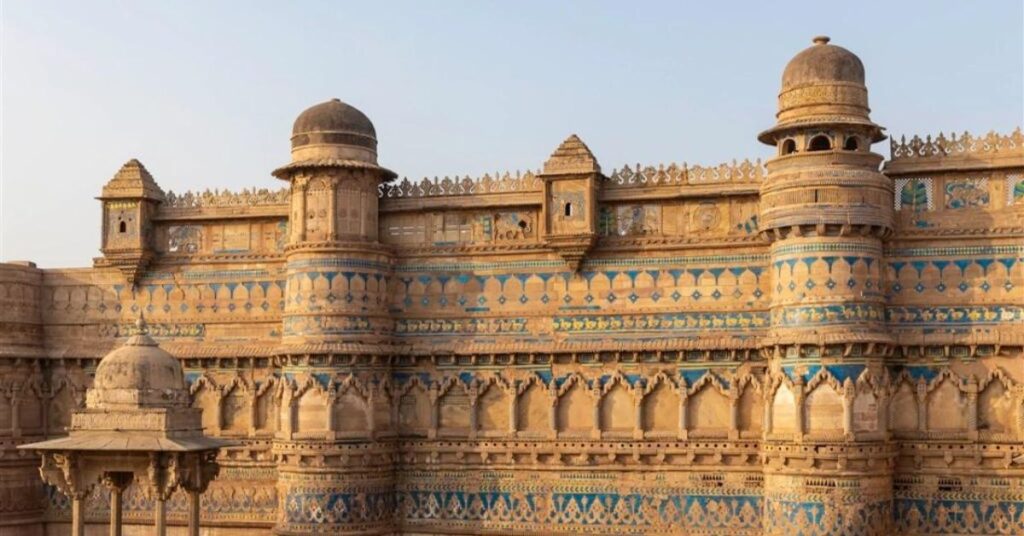
Towering within the walls of Gwalior Fort, Man Singh Palace – also known as the “Painted Palace” – stands as a vibrant testament to the Tomar dynasty’s artistic genius. Raja Man Singh Tomar, who ruled in the 15th century, commissioned this architectural marvel. The palace stuns visitors with its intricate tilework. Imagine a kaleidoscope of blues, greens, and yellows adorning the facades, reflecting the opulent tastes of the era.
Step inside, and the wonders continue. Elaborate carvings and detailed paintings grace the walls, transporting you back in time. These artworks depict scenes from the royal court, the thrill of battles fought, and even religious themes that were central to the lives of the palace inhabitants.
But the palace’s magnificence extends beyond its aesthetics. Its strategic location within the fort offers breathtaking vistas of the surrounding landscape. This vantage point wasn’t just for show – it served a crucial defensive purpose as well.
Gujari Mahal:
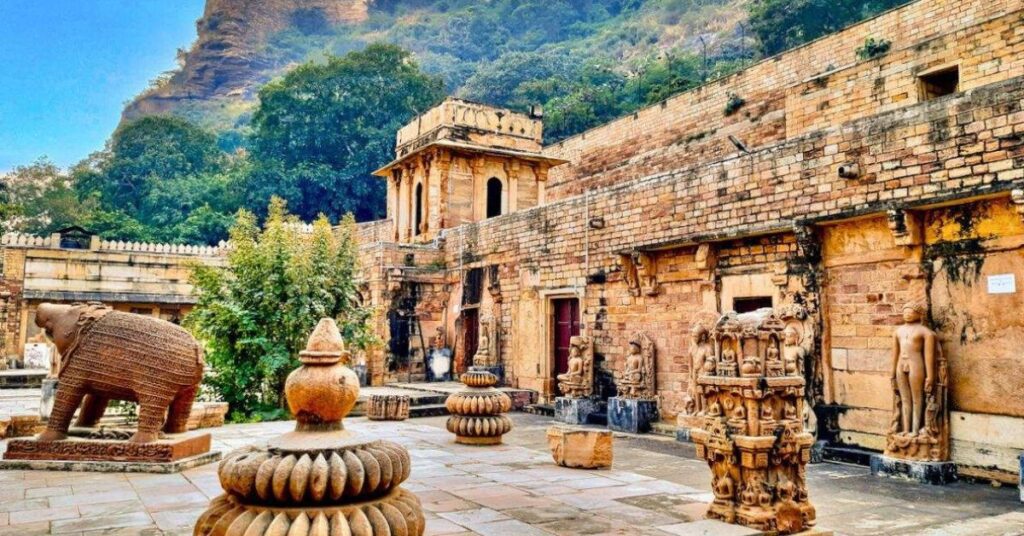
A monument to love and history, Gujari Mahal stands within Gwalior Fort. Legend whispers of its origin as a romantic gesture by Raja Man Singh for his queen, Mrignayani. Built in the 15th century, this architectural gem seamlessly blends defensive strength with delicate beauty. Today, the palace houses an archaeological museum, offering a captivating window into Gwalior’s past.
Walk through the museum, and you’ll be greeted by a treasure trove of artifacts. Ancient sculptures, weathered inscriptions, coins that clink with history, and even weapons – each piece a silent storyteller, whispering tales of the region’s rich tapestry. Look out for the intricate stone carvings and statues from the Gupta and Kachchhapaghata periods.
Sas Bahu Temples:
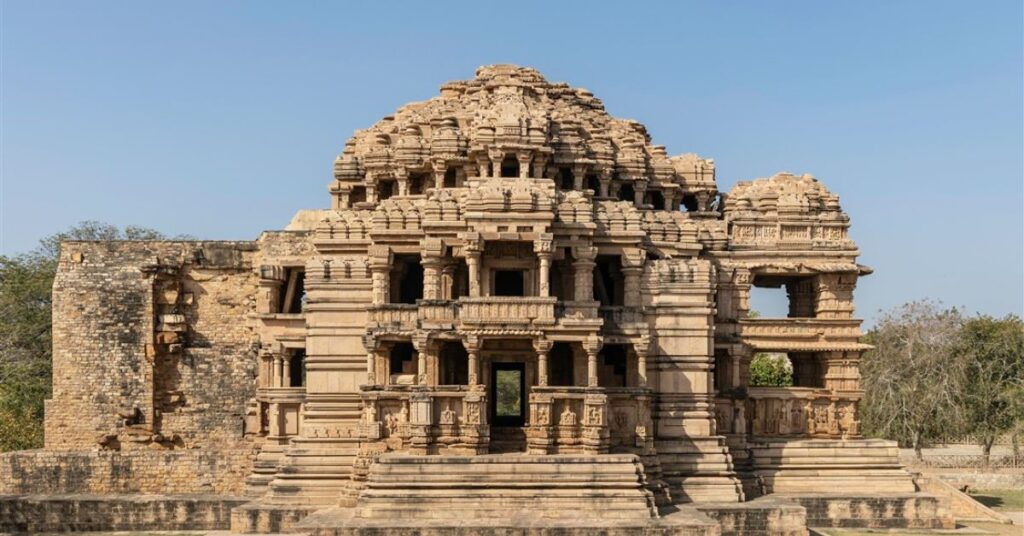
Nestled within the sprawling Gwalior Fort complex are the Sas Bahu Temples, architectural wonders whispering tales of the 11th century. Though their names translate to “Mother-in-Law” (Sas) and “Daughter-in-Law” (Bahu) in Hindi, these temples weren’t built for in-laws! The names simply reflect their sizes – one grand and the other more intimate.
Step closer and marvel at the intricate carvings that adorn these temples. They’re like storybooks etched in stone, showcasing a captivating array of Hindu deities, mythological scenes from ancient epics, and decorative patterns.
Teli Ka Mandir:
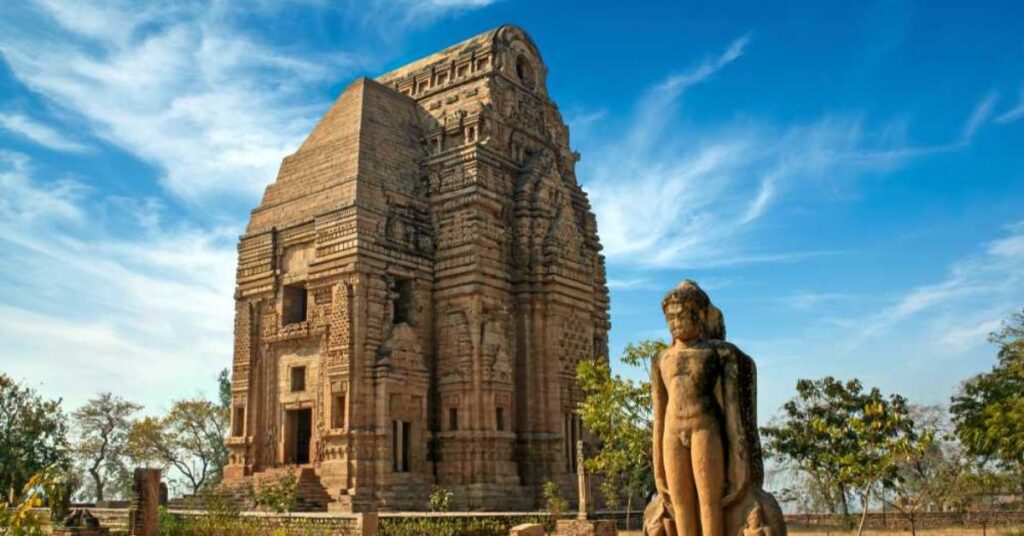
Within the majestic Gwalior Fort complex, Teli Ka Mandir proudly holds its ground as the tallest temple. This 9th-century marvel is a head-turner, thanks to its unique blend of architectural styles. Imagine a rectangular sanctuary, typically North Indian, topped with a curved roof that echoes the South Indian Dravidian gopuram. This fusion is truly a sight to behold!
The temple’s exterior is a canvas bursting with intricate carvings. Look closely, and you’ll see depictions of deities, delicate floral patterns, and geometric designs – each detail a testament to the sculptor’s artistry. Step inside, and the ambience shifts. The interior is designed for serenity, with a focus on spiritual significance rather than ornamentation. This creates a calming space for prayer and reflection.
Gurudwara Data Bandi Chhod:
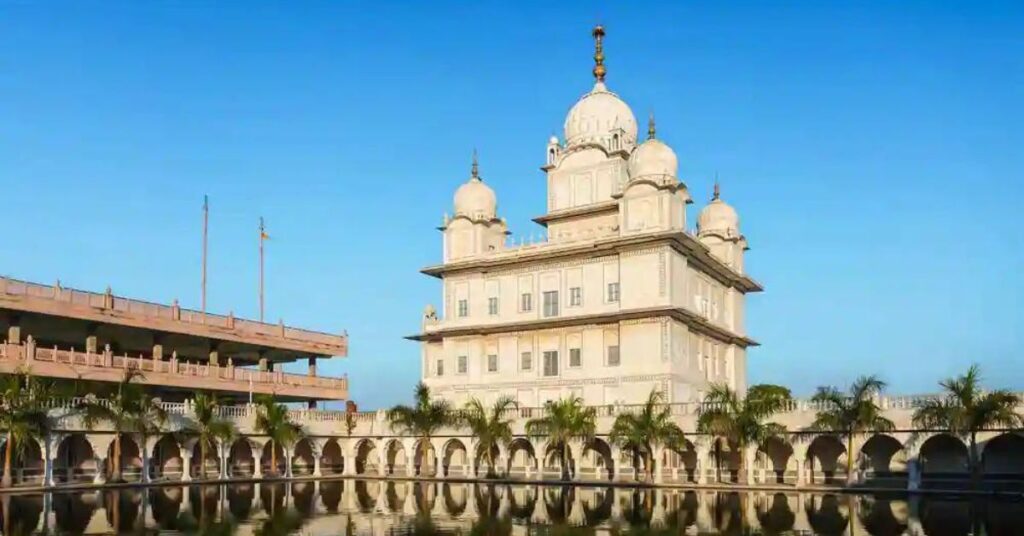
Within Gwalior Fort lies Gurudwara Data Bandi Chhod, a sacred site commemorating the release of the sixth Sikh Guru, Guru Hargobind Sahib, and 52 Hindu princes from Mughal imprisonment. This beacon of Sikh faith draws pilgrims and visitors alike with its serene atmosphere. The Gurudwara’s pristine white facade and elegant domes hint at the spiritual peace within. Step inside the tranquil sanctum, a space for prayer and reflection where the soothing hymns of the Gurbani fill the air. A museum onsite narrates the story of Guru Hargobind Sahib’s historic release, enriching your understanding of Sikh history and values. Gurudwara Data Bandi Chhod’s spiritual and historical significance makes it an essential stop within Gwalior Fort, offering a place for contemplation and cultural immersion.
Local Experiences:
- Wander through the ancient fort: Lose yourself in the labyrinthine alleys, majestic palaces, and sacred temples that whisper tales of bygone eras.
- Attend the Light and Sound Show: Witness the fort’s glorious past come alive through a captivating sound and light show against the dramatic evening backdrop.
- Visit the Tansen Tomb: Pay your respects at the tomb of the legendary musician, Tansen, and soak in the serene ambiance of the surrounding gardens.
- Stroll Through Jai Vilas Palace: Explore the opulent interiors and royal artifacts housed within this magnificent palace, now a museum.
- Shop at Patankar Bazaar: Indulge in retail therapy at the bustling Patankar Bazaar, brimming with traditional handicrafts, textiles, and souvenirs that capture the essence of Gwalior.
- Savor Local Cuisine: Tantalize your taste buds with delectable local fare like kebabs, poha (flattened rice dish), and irresistible sweets at popular eateries and street food stalls.
- Visit the Gwalior Trade Fair (Winter only): If you’re visiting during the winter months, don’t miss the vibrant Gwalior Trade Fair, a shopper’s paradise offering local products, thrilling rides, and captivating cultural performances.
- Experience Local Festivals: Immerse yourself in the festive spirit of Gwalior by participating in vibrant celebrations like the Tansen Music Festival, a celebration of music, and the Gwalior Carnival, a riot of colors and joy.
- Walk Through Sarod Ghar: Delve into the world of the renowned sarod player, Ustad Amjad Ali Khan, at this museum dedicated to his life and works.
- Admire the Sun Temple: Marvel at the architectural marvel of the Sun Temple, a modern structure inspired by the iconic Konark Sun Temple.
- Relax at Phool Bagh: Seek tranquility amidst the verdant expanse of Phool Bagh, a historic garden adorned with cascading fountains and beautiful flora.
- Explore the Jain Sculptures: Uncover the ancient Jain sculptures carved directly into the rock face within the fort complex, a testament to the region’s rich Jain heritage.
- Visit Gurudwara Data Bandi Chhod: Experience the spiritual aura and learn about Sikh history at this revered Gurudwara, commemorating the release of Guru Hargobind Sahib.
- Photograph the Sas Bahu Temples: Capture the intricate details of these architecturally stunning 11th-century twin temples dedicated to Lord Vishnu.
- Learn at the Scindia School: Step onto the hallowed grounds of the Scindia School, a prestigious institution renowned for its academic excellence and historical significance.
Travel tips:
- Pleasant weather awaits: Aim for a visit between October and March when the winter months offer comfortable temperatures for exploring the fort.
- Comfortable shoes are key: The fort complex is extensive, so pack sturdy and comfortable shoes for all the walking and climbing you’ll do.
- Stay hydrated and energized: While vendors are scattered around, bringing your own water and light snacks ensures you stay refreshed and fueled throughout your exploration.
- Gain deeper insights: Consider hiring a local guide to unlock the rich history and significance of the fort’s many attractions.
- Sun protection is essential: Especially during warmer months, pack sunscreen, sunglasses, and a hat to shield yourself from the sun’s rays.
- Plan for the Light and Sound Show: If you’re interested in attending the evening light and sound show, check the showtimes in advance and arrive early to secure a good seat.
- Capture memories: Don’t forget your camera or smartphone to document the stunning architecture and breathtaking views. Be mindful of any photography restrictions that may be in place within certain areas.
- Respect local customs: Dress modestly and be respectful of local customs and traditions, particularly when visiting religious sites within the fort complex.
- Events galore: Research any special events, festivals, or cultural performances happening during your visit to enhance your experience.
- Pack light: Avoid carrying heavy bags as you explore the fort. A small backpack with essentials is all you’ll need.
- Safety first: Exercise caution around steep areas and edges, especially if you’re traveling with children.
- Getting there: Utilize local transportation options like auto-rickshaws or taxis to reach the fort. Negotiate fares beforehand to avoid being overcharged.
- Explore beyond the fort: Allocate some time to visit other nearby attractions like Jai Vilas Palace, Tansen’s Tomb, and the Sun Temple to make your Gwalior trip even more enriching.
- Plan efficiently: Confirm the opening hours of the fort and its various attractions beforehand to ensure a smooth visit.
- Be a responsible visitor: Help preserve this heritage site by properly disposing of waste and following any guidelines set forth by the authorities.
Conclusion
Unravel the captivating story of Madhya Pradesh at Gwalior Fort, a majestic architectural marvel steeped in rich history. Explore its intricate carvings and hidden corners with Xplro.com as your guide. Witness the grandeur of bygone eras – from the Man Singh Palace’s artistry to the serene Gurudwara Data Bandi Chhod. Marvel at towering Jain sculptures, lose yourself in vibrant markets, and be captivated by the fort’s light and sound show. Gwalior Fort is more than a monument; it’s a portal to India’s dynamic past, offering a unique and immersive experience for every traveler.
FAQs
When is the best time to visit Gwalior Fort?
- The ideal time to visit Gwalior Fort is between October and March, during the winter months, when the weather is cool and perfect for exploring.
How can I get to Gwalior Fort?
- You can reach Gwalior Fort by flying into Rajmata Vijaya Raje Scindia Airport, taking a train to Gwalior Junction, or driving. From the city center, you can hire taxis or auto-rickshaws to reach the fort.
What are the visiting hours for Gwalior Fort?
- Gwalior Fort is generally open from 6:00 AM to 5:30 PM, but it’s a good idea to confirm the timings before your visit as they can change.
Is there an entry fee for visiting Gwalior Fort?
- Yes, there is an entry fee for visiting Gwalior Fort. The fee varies for Indian and international tourists, and additional charges may apply for cameras and video equipment.
What are the must-see attractions inside Gwalior Fort?
- Key attractions within Gwalior Fort include Man Singh Palace, Gujari Mahal, Sas Bahu Temples, Teli Ka Mandir, Jain Sculptures, and Gurudwara Data Bandi Chhod.
Does Gwalior Fort have a light and sound show?
- Yes, the fort hosts a light and sound show in the evenings, which dramatizes the fort’s history with an engaging combination of lights, sounds, and narration.
Can I hire a guide at Gwalior Fort?
- Yes, hiring a local guide is recommended to gain deeper insights into the history and significance of the various structures within the fort.
Are there food and refreshment options available at the fort?
- There are some small eateries and vendors around the fort offering snacks and drinks. Bringing your own water and light snacks is also a good idea.
Is Gwalior Fort accessible for people with disabilities?
- While some areas of the fort may be challenging due to stairs and uneven surfaces, efforts are being made to improve accessibility. It’s best to check in advance and plan accordingly.
What should I wear when visiting Gwalior Fort?
- Wear comfortable clothing and sturdy walking shoes. During the summer, opt for light, breathable fabrics, and in the winter, bring a light jacket or sweater.
Are there any festivals or special events at Gwalior Fort?
- Yes, the Tansen Music Festival in December is a major cultural event near the fort, celebrating classical music in honor of the legendary musician Tansen.
Can I take photos inside Gwalior Fort?
- Yes, photography is permitted in most areas of the fort. However, some sections may have restrictions, and there might be an extra fee for cameras. Check the guidelines at the entrance.






